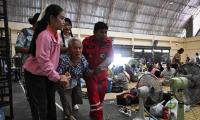Facts take a backseat when a handful of people view well-intentioned developmental agendas through lens smeared with suspicion and an urge for professional recognition.
This often happens when any reform interventions are introduced, particularly those that relate to societal development and bear the potential of stimulating improvement in human capital by enabling all people to carve out a better future for themselves. It is unfortunate that the present government’s initiative of the development of a Single National Curriculum (SNC) for Pakistan has fallen prey to speculation and criticism.
As clearly articulated and accepted in all quarters, there is no contention on the ultimate vision of the SNC. It is clearly intended as a first step towards paving the way for all children to access a level-playing field whether they are in public or private sector schools or madressahs and the multitude of other educational institutions throughout the country. However, it has come under scathing criticism from some quarters.
Most of the criticism of the SNC, coming forth so far, is modernist backlash based on a misperceived notion of Islamization through a heavier content of Islamiat in the SNC as compared to before. Another critique relates to the similarities of the SNC to the 2006 curriculum, with some going so far as churning out software generated mapping studies of the SNC against the 2006 national curriculum and jumping to hurried conclusions of deeming the former as a copy paste job of the latter.
While the imperative of constructive dialogue for gaining a common understanding remains undeniable in a progressive pluralistic society, a legitimate appeal to such critics within the academic community is to first research the issue and gain familiarity with the content and context at hand. More often when over amplified and ill-informed opinions abound, they bear the danger of glossing over legitimate value additions that help achieve common goals and national aspirations.
It is pertinent to note that a curriculum emanates from within a society and is based on its needs and aspirations for the education system to deliver context specific relevant learning within national and global considerations. The 2006 curriculum was a national level undertaking for moving towards a standards, benchmarks and clearly articulated students learning outcomes approach. Unless we hope for a new curriculum to appear by wave of a magic wand, it is only logical to build upon the existing by updating its educational content in line with new societal needs, emerging trends in teaching and learning, and an ever-evolving global context.
The utility of enriching and further streamlining educational content and approaches in a given template that now stands widely understood and owned by implementing stakeholders, leaves little ground for objections. What is important to identify and what comes to fore upon closer examination of the SNC -- if objectively done and all facts considered -- are the underlying key considerations that grace the pages of our national policy documents.
In light of this policy framework, the development of the SNC has remained driven by several overarching considerations, like teachings of the Quran and Sunnah; the constitutional framework; the vision of the Quaid and Iqbal; alignment with international commitments like the SDG-4 Goals and targets; focus on holistic development through teaching of values; life-skills based and inclusive education; respect and appreciation for different cultures and religions in the local and global contexts; activity-based learning; and development of 21st Century skills including analytical, critical and creative thinking.
Whether it be on the grounds of similarities with its precursor (national curriculum 2006) or the alleged heavier Islamic content, the enriched contents of the SNC can only be appreciated upon in-depth study and not mere skimming of its contents.
The observation that the Islamiat SNC content is heavier as compared to before is misguided and non-factual. The curriculum on Islamiat in the SNC, on the contrary, is now aligned to the ‘Compulsory Teaching of Holy Quran Act 2017’. In addition, its structure has been enriched to reflect clearly articulated student learning outcomes which were missing erstwhile. For real life relatability and to promote higher order thinking, two strands, ‘Husn-e-Muamalat aur Muasharat’ and ‘Islami Taleemat aur Dour-e-Hazir ke Taqazay’ have been added and built across the curriculum in an age appropriate manner. The most enriching addition in the SNC’s Islamiat is the move away from passive learning to activity-based learning so that children do not merely memorize but understand and relate their learning from Islamiat to their daily life.
Having established clarity on two key critiques of the SNC, it is also important to appreciate the process elements of SNC development and the credentials and credibility of its developers.
For the purpose of steering and oversight of the SNC development process, the National Curriculum Council was constituted to include education ministers of provinces and areas, heads of curriculum authorities from all federating units, representatives from public and private sector institutions, experts of different streams of education including the public and private school systems, madressahs and representatives of minorities. This rich participatory and inclusive approach was to ensure dialogue for consensus building and accounting for all societal concerns as is globally done for deciding upon educational content enshrined in the curriculum.
At the working level, under a transparent, inclusive and participatory methodology, subject committee members were constituted with the inclusion of a galaxy of 400 star performers including educationists from the public sector, the private sector, the armed forces schooling systems and madressahs from all federating units.
These champions of change, unparalleled in their field of expertise, are none other than education sector professionals including curriculum developers, working teachers and assessment experts from all streams of education. Driven by a common dream and agreed upon key considerations, these professionals engaged in relentless discussions and research to elaborate the SNC Grade pre I-V. Subsequent phases of the SNC will be completed in due course (Phase II: Grade VI – VIII by March 2021; Phase III: Grade IX-XII by March 2022).
At a time when concrete steps are being taken under an all-inclusive participatory approach for updating the blueprint for our children’s education, it is obligatory on all stakeholders to join hands for the national dream of the SNC. The aspiration to standardize the core education content, across all streams of education, is intended as a key move towards providing equitable access to quality education to all children. The government considers the development of the SNC the first step in this direction and envisions reforms in teaching and assessment practices to support implementation of an updated, standardized, student-centered and outcomes-based SNC.
The writer is assistant education adviser at the
Ministry of Federal Education and Professional Training.
Qudratullah Shahab. —TheNews/FileExactly 39 years ago, a great Pakistani personality passed away on July 24, 1986....
This undated photo shows India’s nuclear power plant. — AFP/FileAlarmingly, India possesses a continuous track...
People wade through the flooded street after during the monssoon rain in Rawalpindi on July 17, 2025. — ReutersThe...
This image shows smoke coming out into the air from a coal-fired power plant. — AFP/FilePakistan is no stranger to...
People throng at the Bohri Bazaar in Saddar, Karachi. — AFP/FileThe evolving domestic and international environment...
A voter casts vote in US. — AFP/FileThe Democratic Party has significant work to do if it hopes to bounce back from...







